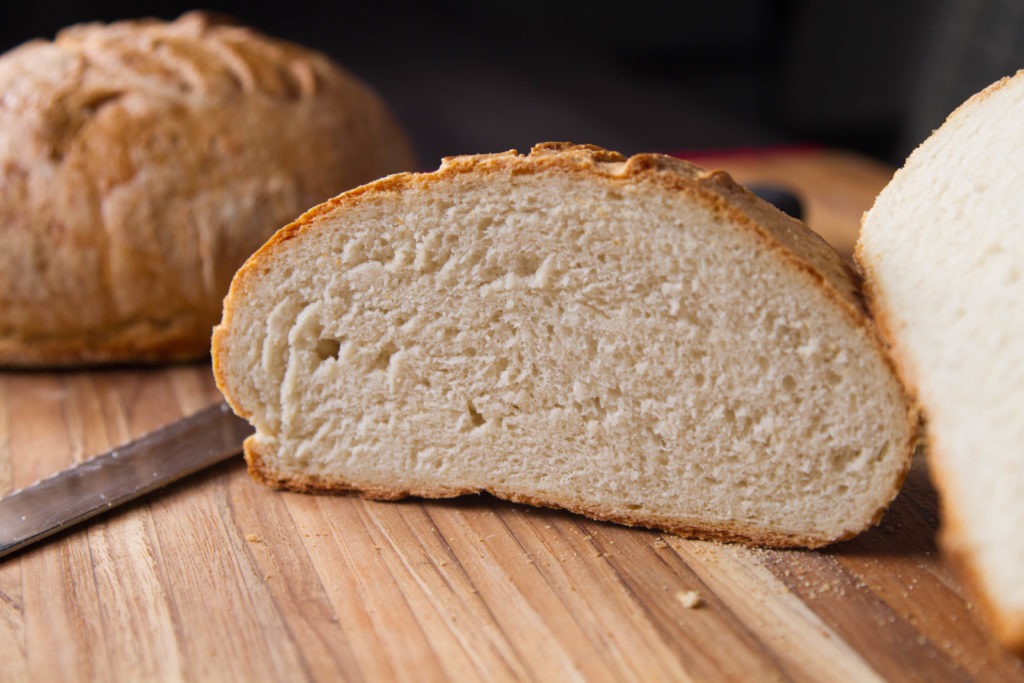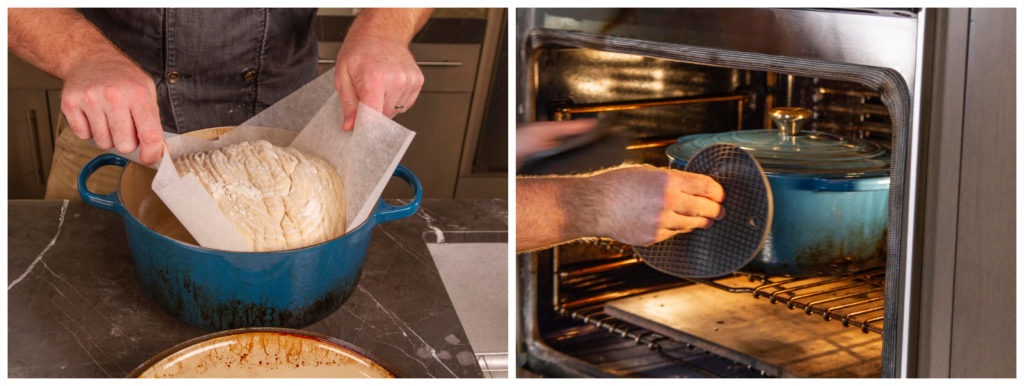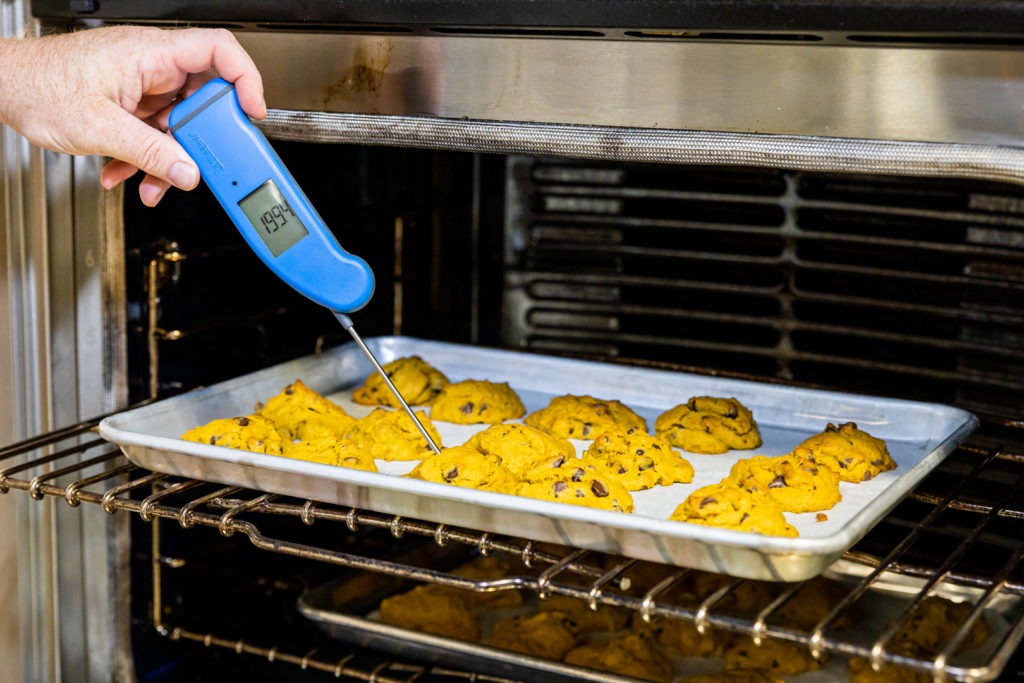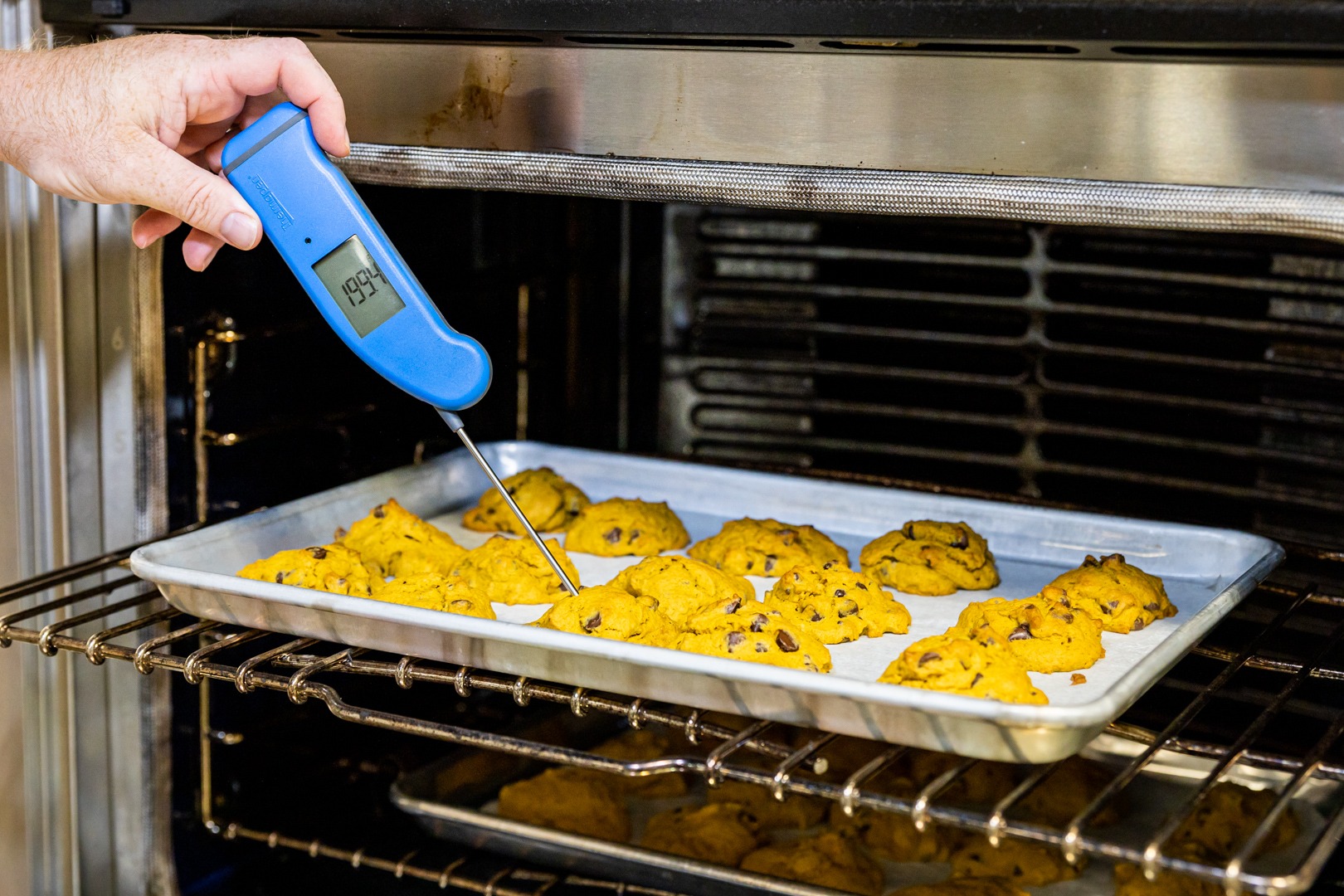Cakes, Breads, Custards, and More: Doneness Temperatures for Baked Goods
There are few smells as good as the smells made by homemade baked goods. And there are few disappointments so full of treachery like cutting into a beautiful lavender-glazed blueberry-lemon poundcake to find the center is still doughy—it’s the things we do to ourselves that hurt the most, right?
Did you know that baked goods have doneness temperatures? They do! Just because our Grandmothers didn’t use fast and accurate digital thermometers to gauge the doneness of their banana bread, sandwich bread, cupcakes, or chocolate chip cookies doesn’t mean that you in a technological age can’t use one to get consistent, repeatable results with every bake.
Here we’ll break down the doneness temperatures for a whole slew of baked goods and the thermometers you can use to check them. Baking is about to get a whole lot more accurate.
Contents:
- Baking doneness and safety
- Bread doneness temperatures
- Quick bread temperatures
- Doneness temps for cakes
- Custard temperatures
- Baked goods temperature chart
Baking and food safety: do I even need to test the temperature?
Some people may ask if doneness temps are necessary when baking. After all, we’ve all eaten raw cookie dough, right? Well, there are two separate things going on here, one is safety and the other is quality.
Let’s just go ahead and address the raw-dough elephant in the room here. Yes, I have eaten cookie dough and brownie batter without getting sick. But I have also probably gotten sick from it. When people think of the risks involved in eating raw dough, they usually think of the potential for salmonella contamination in eggs, and they should think of that, but in fact, there is just as much danger, if not more, in eating the raw flour. Flour is a raw food that poses a risk of pathogenic contamination, specifically from E. Coli. For that reason, flour should not be consumed unless it has been cooked.
Incidentally, chocolate chip cookies are done at 180°F (82°C).
Bread doneness temperatures: 180–210°F, depending on the dough
It is a sad relic of bread-baking history that even in our technologically advanced times, many recipes for bread call for checking its doneness by turning the loaf over and thumping the bottom. “If the bread sounds hollow” they say, it is done. There can be a number of thermal problems with this, depending on what kind of bread you’re baking, but also there is the problem that most of us don’t bake bread enough in our homes to know what “done” bread is supposed to sound like. Yes, it was good enough for your great-great-Grandmother in the village in the old country at the communal ovens, but she was probably baking at least 12 loaves a week, if not more, since she was 10 years old. She knew what bread sounded like!
Bread can be temped either with an instant-read thermometer like Thermapen®® or, by probing it after the first 15–20 minutes of baking (after the oven spring has occurred), with a leave-in probe thermometer like ChefAlarm®.

Rich-dough breads—those with significant fat or sugar content, such as brioche, dinner rolls, challah, or even tender sandwich bread—are done when they reach 180–190°F (82–88°C). Lean dough breads—those with minimal or no fat or sugar, such as baguette, sourdough, most kinds of rye bread, or Cuban bread—cook up at a slightly higher temperature of 190–210°F (88–99°C).



(Within those temps, there is room for variation, of course, so when you find a doneness temp for a certain bread that you think is just right, be sure to note that in your recipe.)
Quick bread doneness temps: 200°F
Pumpkin bread, zucchini bread, muffins, even cornbread and Irish soda bread—these are what the baking world calls quick breads. They are thus named mostly for their leavening: rather than waiting for these to ferment and become light due to yeast action, they are leavened with baking powder or baking soda and acid (this group of leaveners is professionally referred to as chemical leaveners). Double-acting baking powder contains baking soda (a base), cream of tartar (a dried acid), and another dry acid, such as sodium pyrophosphate, which does not react with the baking soda until it is heated. This causes the batter to spring up and lighten in the oven.

Quick breads are, generally speaking, much closer to a thick batter than a cohesive dough, and that higher hydration changes the doneness temp. Quick breads have a doneness temperature of 200°F and up to 205°F (93°C up to 96°C). Your recipe almost certainly gives the time to cook rather than the temperature, so start checking the internal temps with a Thermapen at the low-end of the provided time scale, i.e. at 20 minutes on a recipe that says 20–30 minutes. Pull the cake/bread when it gets to 200°F (93°C) and you’ll never face another soggy-centered banana bread again.

Cake and cupcake doneness temperatures: 200–209°F
How many recipes have you read that say to check the doneness of a cake with a toothpick? I’ve read lots. But a toothpick isn’t actually the best test. Cakes are ultimately only a step or two away from quick breads, and they (mostly) share a common set of doneness temps.
For a “regular” cake that is still moist and tender but isn’t undercooked, use your Thermapen to check the temperature of your cakes. Pull them from the oven once they reach 200–209°F (93–98°C) and ditch the toothpick test. (Use this temp for a delicious pineapple upside-down cake!)
Some cakes, however, are different. Molten chocolate cakes, for instance, are done at a mere 160°F (71°C). At that temperature, the cake has achieved food safety, but the gooey center hasn’t finished firming up. This is certainly one place where the toothpick test won’t tell you everything you need to know! And because of its super-high fat and sugar percentages, pound cake isn’t done until 210°F (99°C).
Custard temperatures: when is it done?
Custards are liquids (usually milk-based) that are thickened by cooking with eggs. Knowing when to pull them from heat can be tricky, as they are often still quite jiggly in their centers when they are done (they congeal more as they cool), and overcooking them leads to grainy textures and unsightly cracking on the surface. But the temperatures these things finish at are not mysteries!

Custards with a high percentage of milk or cream—crème brûlée, flan, and pumpkin pie (as well as other custardy pies) —should be taken from the oven once their internal temps reach 170–175°F (77–79°C). They will still seem rather liquidy, but if you cook them in the oven until they seem solid, you’ll be too late.

Eggy dishes with a higher percentage of eggs, have less milk in the way of their proteins binding together. So things like quiche, bread pudding, and meringue pies are done at 160°F (71°C). A quick check with a Thermapen® will let you know when you get there.
Cheesecake doneness temperature
Because of its unique composition and size, cheesecake has its own doneness temperature, 150°F (66°C). Pulling your cheesecake form the oven at a mere 150°F (66°C) will prevent cracking and will help keep your cheesecake moist and tender, not gritty and dry. For a bang-up recipe, look to our post on New York-style cheesecake.

Baked goods temperature chart
| Baked good | Pull Temperature |
| Chocolate chip cookies | 180°F (82°C) |
| Rich-dough breads | 180–190°F (82–88°C) |
| Lean-dough breads | 190–210°F (88–99°C) |
| Quick breads, muffins, cornbread, biscuits, scones | 200–205°F (93–96°C) |
| Cake, cupcakes, angel food cake | 200–209°F (93–98°C) |
| Molten (lava) cake | 160°F (71°C) |
| Pound cake | 210°F (99°C) |
| Crème brûlée, flan, pumpkin pie | 170–175°F (77–79°C) |
| Bread pudding, quiche, meringue pies | 160°F (71°C) |
| Cheesecake | 150°F (66°C) |
There’s no reason to leave the outcome of your favorite baked goods to chance or poorly written recipes. Use an instant read thermometer that is fast and accurate, like the Thermapen, to make sure none of your baked goods come out as baked bads. Forget the disappointment of bad bakes and enjoy the results of real temperature monitoring and control.
Shop now for products used in this post:



Good looking Bread!
Excellent reference.
What is the doneness temperature for cheesecake?
David,
Good question. I’ve edited the post to get that info in there. Cheesecakes should be pulled from the oven at 150°F (66°C).
Chef Earl,
I enjoy your cooking insights, tips, and ideas for new ways to cook. The Thermoworks devices I own are great tools for expanding my skills.
I cook many things, but baking only accounts for about 5% of my kitchen time. I know that water boils at a notably lower temperatures as altitude increases and that is why adjustments to baking ingredients should be made for recipes made at altitude.
Since the temperature being measured in a muffin or cake is actually the temperature of the water (or steam) in the dough as it cooks, how do I adjust these temps for altitude? I live at 6500 feet and water boils here at 200 F. The laws of physics are going to prevent that water from reaching the target temp in this chart, so how do I compensate for that?
Ward,
That’s a good question. Water boils here at our building around 203°F, do it does pose a challenge in some respects. I don’t have an exact answer for you, but I have some principles that may help.
First, the water in a cake is far distant from pure, and your local boiling temp is for pure water. Saltwater, for instance, boils hotter, as do sugar syrups—that’s how we gauge the concentration of sugar syrups. In a cake, for instance, the concentration of “impurities” in the water is quite high, so a higher-than-boiling temp should be possible in the oven.
That being said, the doneness of a cake is more contingent on the gelation of starches and the denaturing of proteins than it is on the evaporation of water. True, in candy making we are measuring how much water has left the candy to know when to stop cooking it, but for baked goods, the temperature is more indicative of how much energy has had the opportunity to work on the non-water ingredients. Egg (and gluten) proteins don’t denature with air temperature based on atmospheric pressure, they denature and scramble based solely on their own exposure to heat. The same goes for starches to some extent.
Finally, for some anecdotal evidence, I can say that these temps have worked wonderfully well at my elevation—about 4,500 ft.
I Hope that helps! Happy cooking!
Thanks, that info helps a lot. I’ll give it a try.
I have been baking gluten-free for over ten years now, and I don’t know what I would do without my Thermapen and my Dot. I used to have failure after failure when trying to make GF breads until I started to rely on a food scale, a thermometer, and recipes that utilize both those tools in their instructions. I’m still learning, and found the information in this post to be very helpful. Thank you!
How wonderful to offer this chart with internal temperatures of baked goods. I’ve always said that the thumping test for doneness for bread may work if one has perfect pitch but not for me. I so prefer taking the temperature and thanks to the Thermapen I’m able to do it with reliable accuracy in my upcoming “the cookie bible” I’ve found that different cookies have very different finished temperatures and have actually listed them.
Wow!!!! Look who replied on this thread!!! Amazing- hats off to you!!
Hi Rose, I love the preciseness of your recipes. I am a long time fan!
Are doneness temperatures for baked goods dependent on altitude? We live at about 4800 ft. above sea level and water boils at 209ºF. I know I need to adjust candy-making temperatures but haven’t been able to find out if baking temps are absolute or boiling-water-temp-relative. Thanks.
Doneness temps for baked goods are based on changes in protein and starch structures, which are independent of elevation. I cook at about the same elevation as you and find no difference in doneness temps for these things. For candy, YES! But not for baked goods.
what is the temperature goal for cake type brownies?
Cake-type brownies should be done at the low end of the cake-temps range, shoot for about 200°F.
I bake spaghetti pie which is comprised of cooked spaghetti, eggs, parmesan cheese and black pepper enclosed in a pie crust made with lard, flour and eggs. It bakes in a 12″ wide x 3″ deep round pan at 375 degrees F. Could you tell me what internal temp would yield a fully baked dish without liquidy eggs in the center?
Shoot for 180°F. By that temp, both the whites and the yolks will have set up.
Thank you for this article and the temperature chart. It’s a great resource! Can you recommend a temperature for Clafoutis?
Good question! I’d probably shoot for something in the neighborhood of 195°F. That’s based on the high sugar content and density of the finished product…it’s almost like a more sugary poundcake. I think at that temp it should still be plenty moist but also be well set up.
Excellent article and exactly what I was looking for. I’m just starting out on this temperature for baking thing… this will be very interesting! Love all the articles here….
Are there any temperatures for fruit pies?
Suzanne,
That is a question with which I have struggled. There ought to be, but I think it depends greatly on several factors that make it hard to nail one answer down. Is the filling precooked? If so, we’re just warming it and getting any top crust baked, no temp needed. Is it raw fruit mixed with a starch of some kind? Well, we’ll need those starches to gelatinize, which means we’re going to hit somewhere in the neighborhood of boiling, 200–212°F. How much starch and what kind may have an effect on the final temp needed. Then there are things like strawberry pies, where we gleatinize the starch and mix the berries in later—that won’t need a final tmp on the pie itself. That may be vague, cut it’s all I have so far!
In general, I’d guess most firuit pies are looking for 200°F+ for a good filling set and fruit tenderness.
I am thrilled to have found your site! My muffins were perfect! I’m accustomed to using jumbo baking cups, and wasn’t sure how long to bake the standard cupcake size – Excellent information to have! Thank you; and why haven’t thought of this sooner!?!
I bake pie – I haven’t checked the temperature of a baked fruit pie, but I can advise about pecan pie. I’ve recently increased my pie pan size from 9″ – 11″ which allows 8 generous slices rather than 6. My point is that it was difficult to determine whether such a large pecan pie was done. After making several soupy ones (unknown until cutting, as you described your lovely but doughy blueberry lemon pound cake)
I’ve discovered that baking the pecan pie until the center of the pie registers 198-200 degrees assures a nicely textured pie. For my larger pie, I bake for about an hour, covering with foil for the first 15-30 minutes to avoid over-browning.
Fantastic! I’m happy you found us and that things are baking up better for you already!
Can You tell me if the same internal temps for gluten and gluten free baked goods are the same. You have 200 degrees for a quick bread, would it be the same for a gluten free flour or almond flour quick bread? Thank you for your time, Susan
Yes! You nailed it—GF breads are generally done around 200°F. We also published a post about GF baking that goes into a little more detail.
Can You tell me if the same internal temps are for both gluten and gluten free baked goods. You have 200 degrees for quick bread, would it be the same for a quick bread made with gluten free flour or almond flour? Thank you for your time, Susan
In general, yes, treat a GF bread like a quickbread.
How about adding some temp guidance for gluten free bread?
I asked our coworker with celiac about this, and he gave the following advice.
Rather than using a gluten recipe and making substitutions, Use one that is made to be gluten free. The best recipes for breads will be engineered gluten-free form the beginning.
You will need a leave-in probe thermometer for best results. Put the probe in after about 20 minutes of baking (for a loaf…sooner for rolls). Also, if the recipe includes any temperatures for water, milk, butter, etc, you need to hit those spot-on or the recipe won’t work right (ingredient effects are amplified with gluten-free bread, so it’s even more important here.)
And, even more than with yeast breads, you need to let the bread cool completely before cutting in to it. You can warm a slice later, but don’t try to take one hot from the loaf.
For quick breads, the pull temp is usually the same as for gluten recipes. Yeast breads are usually about 5°F higher than a gluten recipe.
He also recommends using gloves for any kneading or forming, as these doughs are much stickier.
Wondering if the 180 degree recommendation for cookies is low for “doneness”? Cooked a couple batches of sugar cookies and pulled at 180-190 degree range and when cooled were substantially undercooked. They were not particularly large or thick.
It will change from cookie to cookie, depending on the batter/dough, but it shouldn’t vary too widely. Try tacking on 5°F for that recipe. When you find a doneness you like, wrote the doneness temp on your recipe card so anyone can get it right, too!
I know i am late with this question, but am wondering about carrot cake…lots of carrots, lots of oil. I baked it to 210 F, and it turned out overly wet/moist. Is there a specific temp for carrot cake? Love your guide…really appreciate it!!
Hmmm…interesting. We haven’t had that experience here, but if it’s coming out too wet, try increasing your doneness by 3–5°F. Or maybe increase your flour a little bit, which willl help spread that moisture around and cook up better.
I’m wavering on which category to put sticky toffee pudding in, quick bread (for the leavening, baking powder and soda) or does one egg to a cup of flour make it an ‘eggy’ dish, or perhaps it fits in the molten chocolate cake category for moistness? I am so grateful for your chart, it has saved my cheesecakes over and over 😁
Oooh, that’s a tricky question! I’d go with something like a molten cake for it. I’m afraid the higher temp of the quick bread temp will be too hot and will make it less sticky. If you find it underdone, add 5 degrees next time. When you get it juuuuust right, wrote that number in the recipe for the future!
Thank you! I hate stabbing my bread with a toothpick and having it come out covered in chocolate, and wondering if it would have come out clean if it weren’t for the chocolate chips lol
Hi, what is the pull temperature for a non-gluten cake using rice flour?
For rice-flour cakes the doneness temp is roughly the same, but can range up to 5°F higher than flour cakes. So, 205–214°F.
This is a great reference! What do you recommend for fudgy brownies?
We recently did a post about brownie temps! In general, we shoot for 200°F for them.
Would you have a doneness temp for gluten-free bread, both rich and lean types. Many recipes call for 209F but my bread comes out crumbly at that temp. Thank you
WE find that 200°F is better for most GF breads. But letting them cool COMPLETELY is super important, too.
Hello Chef Martin,
I live in Toronto , Ontario Canada. I just checked and it says Toronto is only 250 feet above sea level. How much would I adjust these temperatures?
My daughter recently had a lemon loaf bread that look cooked, and toothpick showed done but when cutting it , it was still raw.
I just did a recipe and in my 55 years of baking the recipe had a degree for doneness. I ended up pulling from the oven 10 minutes early, it was very dark. They said 190 F for doneness.
Thank you !
At 250ft, the differences should be negligible. That lemon loaf is a perfect illustration of why temping things beats toothpicking them, though!
I teach foods classes to high school students, ages 14-18, and they are so ready to EAT that they will pull pale products that look like supermarket products. Love your chart, and now I have found a good reason to teach how to use the instant-read thermometer in Foods I. Do you have a temp for biscuits and scones?
Thanks,
Caryl
Yes! It’s the same as for quickbreads, 200–205°F.
So helpful! What do you recommend the internal temperature be for biscotti?
If we’re looking for full dehydration, i'[d tryo to get up to your local boiling point. Up here in the mountains, that’s 204°F, but if you’re by the sea, maybe go for 210 0r 212°F. Try a asmall batch first, then edapt and record your results form there.
I encourage you to collaborate with Cooks or America’s Test Kitchen on a cookbook that focuses on best internal temperature of each dish. Ovens are too quirky ! I made a box white cake mix (I know many are cringing). But good quick recipe for coconut cake with delicious coconut cream cheese frosting. Final temp was 208. We shall see…
That’s a fun idea!